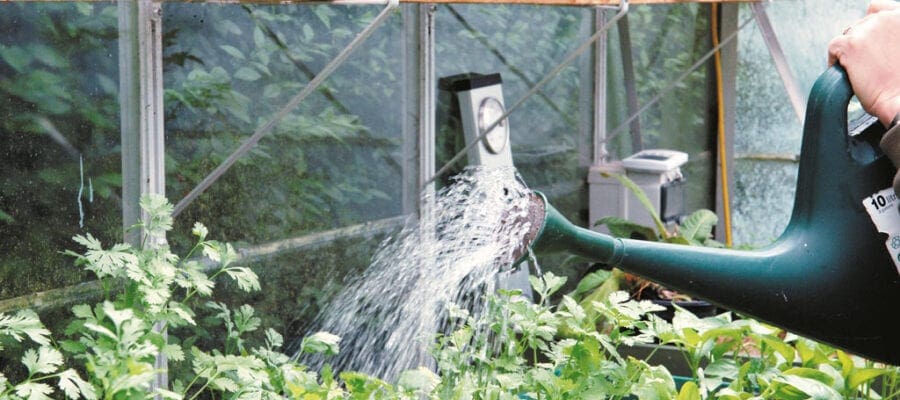
Watering is particularly important at seed sowing time, planting out and just after seedlings emerge. Once vegetables become established it is less important unless you garden on very free-draining soil.
Root level irrigation
On very dry soils or for crops that prefer a moist soil such as celery or celeriac then you could consider using porous pipes that are connected to a hosepipe and start watering along their length. With this system is you are directing water to the base of the plant where it is needed and keeping the foliage dry.
Feeding time
All plants require three main nutrients – nitrogen, phosphorus and potassium often denoted as NPK. The plant’s requirement for these nutrients is complicated but to simplify – nitrogen is important for growth and the green parts of the plant, potassium is necessary for bud and flower formation and phosphorus is a nutrient that matures and hardens up a plant as well as good for root growth.
The amounts of these nutrients can vary in different fertilisers. For example a tomato fertiliser is usually higher in potassium because tomatoes need more of this nutrient to flower and fruit well. Some fertilisers are called balanced which means they contain equal amounts of N:P:K. These are good multi-purpose feeds that are useful throughout the season. Some plants such as tomatoes like a rich soil so regular feeding is vital.

Apply in spring
Adequate nutrients in the soil are vital to ensure the optimum growth and health of your vegetables and spring is the time when a sprinkling of fertiliser will do the most good. The winter rains will have washed through some of the nutrients especially on light sandy soils.
Organic feeds If you prefer to garden organically then there is arange of fertlisers for you. Most are general purpose, however, there are more coming on to the market that are plant specific such as organic tomato feeds. Most of the powder or pelleted forms are also classed as slow-release meaning they are broken down by the soil micro-organisms gradually releasing nutrients.
Traditional blood, fish and bonemeal is still available either mixed to create a balanced fertiliser or individually. Blood is high in nitrogen, fish high in potassium and bonemeal high in phosphate. Comfrey pellets (Organic Gardening Catalogue) is a pleasant alternative to making your own smelly fertiliser by compressing comfrey leaves.
The pellets can be applied to the soil or turned into a liquid feed. Calcified seaweed products made from sustainable sources of seaweed are a great soil conditioner and also contain many trace elements. Some seaweed organic fertilisers are said to improve a plant’s ability to fight disease and withstand stress.
Applying fertilisers
A sprinkling of any general feed can be applied before sowing, but avoid manmade quick-acting fertilisers at sowing time such as sulphate of ammonia which can cause scorching. Overfeeding is as bad as underfeeding. We have all seen forked carrots –often the result of high nutrient levels. Also masses of foliage and no fruit is common on newly planted fruit trees. It is best to apply sparingly and to the manufacturers recommendations or to get the soil tested occasionally.
Getting your soil tested
You can buy kits from garden centres to test for the main nutrients and soil pH. Similar kits are available by mail order. You can also send soil samples away to laboratories such as Lancrop Laboratories tel: 01759 305116. (www.lancrop.com). They provide a professional soil testing service. It is likely to be more expensive but certainly very accurate and could save you money on buying needless costly fertilisers.











